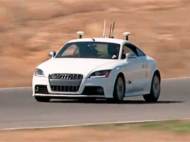Shelley – self-driving robotic racecar
 Researchers from Stanford University cooperated with the Volkswagen Electronics Research Lab to develop Shelley – a self-driving Audi TTS that recently managed to reach 193 km/h (120 mph) on a recent track test at Thunderhill Raceway, north of Sacramento, California. The car managed to autonomously get around the course in less than two and a half minutes – a time that rivals those achieved by professional drivers.
Researchers from Stanford University cooperated with the Volkswagen Electronics Research Lab to develop Shelley – a self-driving Audi TTS that recently managed to reach 193 km/h (120 mph) on a recent track test at Thunderhill Raceway, north of Sacramento, California. The car managed to autonomously get around the course in less than two and a half minutes – a time that rivals those achieved by professional drivers.
The self-driving car is the product of collaboration between Stanford’s Dynamic Design Lab, led by mechanical engineering Associate Professor Chris Gerdes, and the Volkswagen Electronics Research Lab. From the outside, Shelley looks as other Audi TTS with some decals and a few extra antennas, there’s nothing outwardly remarkable about the white car zipping around the track.
Earlier this summer, Gerdes’ group brought Shelley to Thunderhill for high-speed tests of the latest tweaks to the software that tells her when to brake, how tight to take turns and when to punch the gas. Although most of the autonomous cars are developed to drive at lower speed until their software and decision algorithms evolve, the experience and data gathered by running Shelley around the track at high speeds could one day lead to fully autonomous cars that could transport you at higher speeds while maintaining safety.
Although the route charted by Shelley’s algorithms are fairly similar to those chosen by the professional drivers, the very best human drivers still manage to beat the autonomous car by a few seconds. Shelley computes the fastest line around a course and executes the exact corrections required to stick to it, while a person relies on feel and intuition that can buy those precious few seconds by allowing the car to swing too wide in one turn to achieve higher speeds in parts of the track where it counts.
During the Rolex Monterey Motorsports Reunion races at the Laguna Seca Raceway (Aug. 17-19), Gerdes and his students will have the opportunity to combine their findings with data gathered from professional drivers’ brain activity in order to improve their algorithms. The group has enlisted two professional drivers to wear a suite of biological sensors as they race around the track in order to record their body temperature, heart rate, as well as their brain activity while they race against other humans.
The biological data will be paired with mechanical performance data from the 1966 Ford GT40 which is equipped with feedback sensors similar to those on Shelley.
“We need to know what the best drivers do that makes them so successful”, said Gerdes. “If we can pair that with the vehicle dynamics data, we can better use the car’s capabilities.”
Aside improving performance of vehicles and professional drivers, the technology could be useful as an onboard co-pilot that aids the driver in order to increase the grip of the pavement or recover form a slide on a patch of ice. There’s still a lot of work to be done to increase the safety and longevity of the vehicle and its parts, since Gerdes and his research group managed to push Shelley to its limits by melting its brake pads its last run on Thunderhill.









Leave your response!